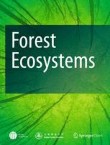Tree growth is more limited by drought in rear-edge forests most of the times
Equatorward, rear-edge tree populations are natural monitors to estimate species vulnerability to climate change. According to biogeographical theory, exposition to drought events increases with increasing ari...
